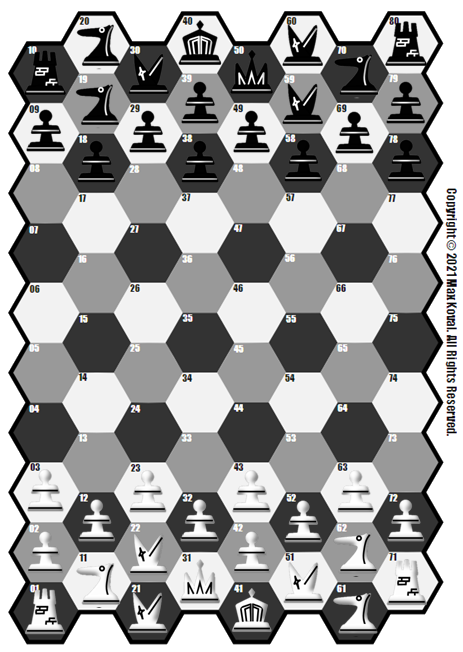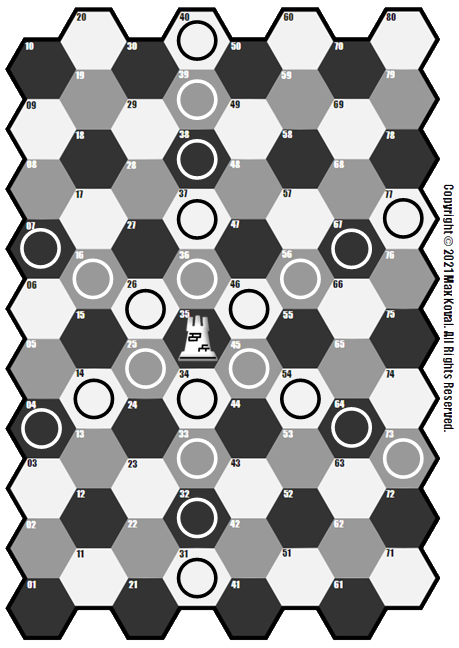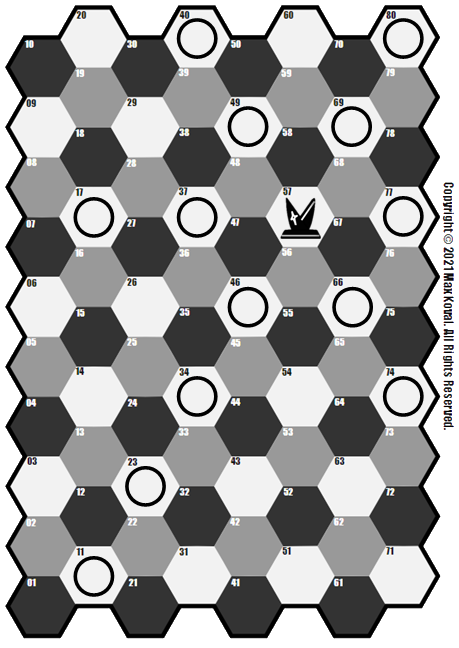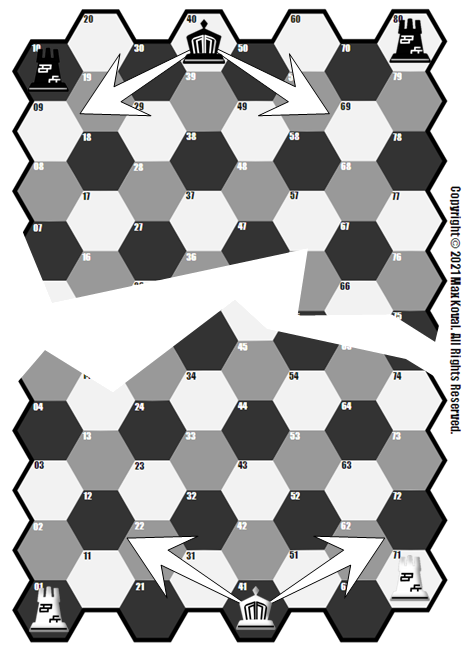Ultimate Hexagonal Chess
Ultimate Hexagonal Chess is a two-player hexagonal chess variant invented by Max Koval in 2021 and first published on Chessvariants.com. This game uses a new board with 80 hexagonal cells and a set of 40 chess pieces.

My main idea of this variant was to create hexagonal chess in the closest possible way to its orthodox ancestor. This game saves some original chess features, not existing in other major hexagonal variants, such as the proportion between empty and taken cells (50% against 50%), its external design (black-celled white king, white-celled white queen, etc.) and rules (Unlike other vertical hexagonal variants, it actually retains both short and long castling).
I hope you'll enjoy this variant. Please pay attention that the design of the pieces which I used in the following diagrams is not free, and if you want to use them in your projects, be kind to credit the artist. Any commercial reproduction of this board and pieces setup is prohibited.
Setup

White has: one king (41), one queen (31), two rooks (01,71), three knights (11,61,62), three bishops (21,22,51), ten pawns (02,03,12,23,32,42,43,52,63,72).
Black has: one king (40), one queen (50), two rooks (10,80), three knights (19,20,70), three bishops (30,59,60), ten pawns (09,18,29,38,39,49,58,69,78,79).
Pieces
The movements (as well as the names of the pieces) are logically similar to orthodox chess (with the remark that it is transcripted for a hexagonal board).
Rook (Orthogonal moves):

Bishop (Diagonal moves):

Queen (Combines both diagonal and orthogonal moves):

King (One cell in orthogonal or diagonal direction; cannot move to the cells attacked by the pieces of opposite color):

Castling is allowed:
White: K41-62 & R71-52 for short castling (0-0); K41-22 & R01-32 for long castling (0-0-0).
Black: K40-19 & R10-29 for short castling (0-0); K40-59 & R80-49 for long castling (0-0-0).


All the castling exceptions used in orthodox chess should be applied.
Knight (One cell in hippogonal direction):

Pawn (One cell orthogonally without taking straight forward and capture only diagonally forward):

The pawn can move only forward until its promotion (The promotion cells are 10,20,30,40,50,60,70,80 for White; 01,11,21,31,41,51,61,71 for Black).
Any pawn can make a double step (like in orthodox chess) if it is placed on 03,23,43,63 (White), or 18,38,58,78 (Black). The pawns, placed on 02,12,32,42,52,72 (White), and 09,29,39,49,69,79 (Black), can make a triple step (for instance, the white pawn on 12 can make a triple step to 15 or double step to 14).
En passant is allowed and works similarly to orthodox chess.
Rules
Ultimate Hexagonal Chess is a two-player board game based on chess. This game uses standard chess pieces (plus some additional) and should be played on a new board with 80 triple-colored cells.
The main difference between this game and orthodox chess are the castling rules, board shape, pawn movement, and the number of pieces.
If the player has not moved his pawn from the initial starting lines (including two additional cells per side where the gray colored knight and bishop are placed), it also can attack 'diagonally' sideways (i.e., white pawn, placed on 32 can capture (but not passively move) black pieces if they would stand on 12 and 52).
This was done to protect pawns, placed on 03 and 78, which are initially unprotected without this rule, and can be attacked by the opponent's bishop. It was also developed to make the initial arrays where pawns are placed more stable, which result it their slightly increased worth. As estimated, the worth of the queen in major hexagonal variants is 12 pawns. By increasing the pawn's worth it can be actually reduced to something about 10 pawns, which makes the game slightly more balanced in material ratio. At the same time, it gives additional positional worth to the bishop, and, together with narrower board, makes it worth almost as similar as the knight (bishop is slightly more valuable in orthodox chess, the same thing in reverse can be seen here).
'White' moves first, 'Black' moves next. The main goal of this game is to checkmate the opponent's king and so on. All the rules are similar to standard FIDE chess.
Copyright © 2021 by Max Koval. No part of this text or images may be reproduced on other websites in any manner.
 This 'user submitted' page is a collaboration between the posting user and the Chess Variant Pages. Registered contributors to the Chess Variant Pages have the ability to post their own works, subject to review and editing by the Chess Variant Pages Editorial Staff.
This 'user submitted' page is a collaboration between the posting user and the Chess Variant Pages. Registered contributors to the Chess Variant Pages have the ability to post their own works, subject to review and editing by the Chess Variant Pages Editorial Staff.
By Max Koval.
Web page created: 2022-01-01. Web page last updated: 2022-05-27
